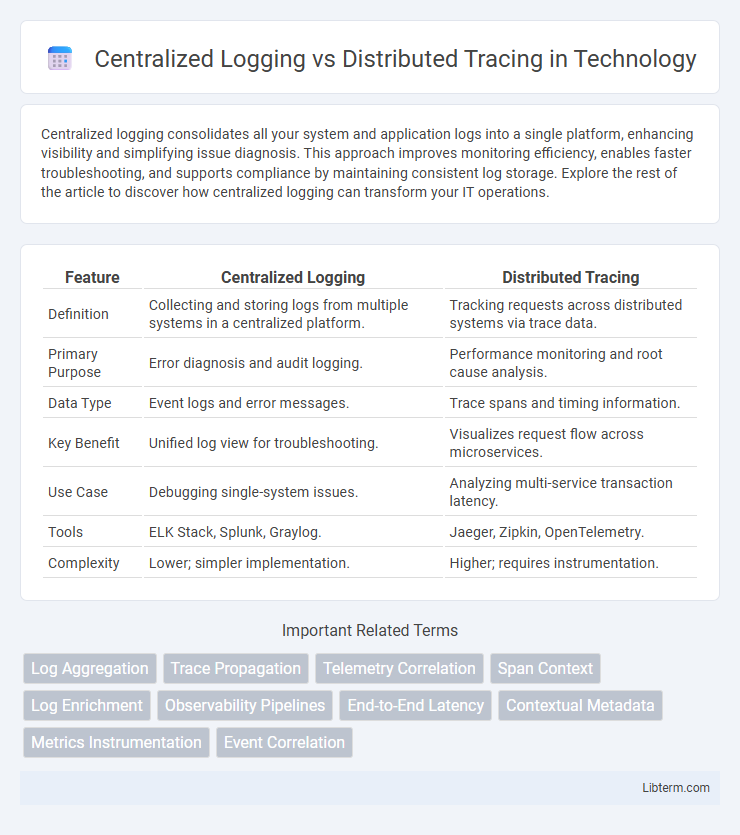Centralized logging consolidates all your system and application logs into a single platform, enhancing visibility and simplifying issue diagnosis. This approach improves monitoring efficiency, enables faster troubleshooting, and supports compliance by maintaining consistent log storage. Explore the rest of the article to discover how centralized logging can transform your IT operations.
Table of Comparison
| Feature | Centralized Logging | Distributed Tracing |
|---|---|---|
| Definition | Collecting and storing logs from multiple systems in a centralized platform. | Tracking requests across distributed systems via trace data. |
| Primary Purpose | Error diagnosis and audit logging. | Performance monitoring and root cause analysis. |
| Data Type | Event logs and error messages. | Trace spans and timing information. |
| Key Benefit | Unified log view for troubleshooting. | Visualizes request flow across microservices. |
| Use Case | Debugging single-system issues. | Analyzing multi-service transaction latency. |
| Tools | ELK Stack, Splunk, Graylog. | Jaeger, Zipkin, OpenTelemetry. |
| Complexity | Lower; simpler implementation. | Higher; requires instrumentation. |
Introduction to Observability: Centralized Logging and Distributed Tracing
Centralized logging collects and stores logs from various systems in a single repository, enabling efficient search and analysis for troubleshooting and monitoring purposes. Distributed tracing tracks requests as they propagate through microservices architectures, providing detailed visibility into latency, bottlenecks, and inter-service dependencies. Together, centralized logging and distributed tracing form the foundation of observability frameworks that enhance system reliability and performance diagnostics.
Defining Centralized Logging: Features and Use Cases
Centralized logging aggregates log data from multiple sources into a single repository, enabling efficient storage, search, and analysis of system events. Key features include real-time log collection, indexing for fast retrieval, and integration with alerting and visualization tools. Use cases span from troubleshooting application errors and monitoring system performance to compliance auditing and security incident detection.
Understanding Distributed Tracing: Core Concepts
Distributed tracing helps track requests as they flow through microservices, capturing detailed timing and context data for each segment of a transaction. It uses unique trace IDs to link spans across different services, enabling root cause analysis and performance optimization in complex distributed systems. This granular visibility differentiates it from centralized logging, which aggregates logs but lacks the contextual relationship between service interactions.
Key Differences Between Centralized Logging and Distributed Tracing
Centralized logging aggregates log data from multiple sources into a single repository, enabling comprehensive search and analysis of system events, while distributed tracing tracks the lifecycle of a request across various services, providing detailed insights into request paths and performance bottlenecks. Key differences include their primary focus: centralized logging emphasizes event record aggregation and troubleshooting, whereas distributed tracing concentrates on request flow and latency measurement. Centralized logging handles large volumes of log entries, often using tools like ELK Stack or Splunk, whereas distributed tracing employs tracers such as Jaeger or Zipkin to map service interactions and pinpoint delays in microservices architectures.
Pros and Cons of Centralized Logging
Centralized logging consolidates application and system logs into a single platform, enhancing searchability and simplifying fault diagnosis across complex environments. It improves security monitoring with unified access controls but faces challenges related to storage costs, potential data loss during high-volume spikes, and scaling complexities. While centralized logging offers comprehensive visibility, it may struggle to correlate events across microservices without complementary tools like distributed tracing.
Advantages and Challenges of Distributed Tracing
Distributed tracing offers enhanced visibility into complex, microservices-based architectures by tracking requests across multiple services, enabling precise performance monitoring and faster root cause analysis. Its advantages include detailed end-to-end transaction insights and improved service dependency mapping, which facilitate proactive issue detection and optimization. Challenges involve managing large volumes of trace data, ensuring consistent trace context propagation, and addressing overhead that may impact system performance.
When to Choose Centralized Logging Over Distributed Tracing
Choose centralized logging when your primary goal is to collect, store, and analyze large volumes of log data from multiple sources in a single location for easy search and troubleshooting. Centralized logging is ideal for identifying system-wide issues, audit trails, and security compliance, especially in simpler architectures or when deep performance insights are not essential. It provides a straightforward approach to log management without the complexity of tracing individual requests across distributed services.
Integrating Logging and Tracing for Complete Observability
Integrating centralized logging with distributed tracing enhances complete observability by combining comprehensive log aggregation and real-time trace visualization, enabling faster root cause analysis across complex microservices environments. Centralized logging collects and stores logs from diverse sources into a unified platform, while distributed tracing tracks the end-to-end flow of requests through multiple services. This integration allows teams to correlate detailed logs with trace spans, improving system performance monitoring, error diagnosis, and troubleshooting efficiency.
Popular Tools for Centralized Logging and Distributed Tracing
Popular tools for centralized logging include Elasticsearch, Logstash, and Kibana (ELK Stack), which enable efficient aggregation, storage, and visualization of log data from diverse sources. For distributed tracing, prominent tools such as Jaeger, Zipkin, and OpenTelemetry provide robust capabilities for tracking requests across microservices, helping identify latency and performance bottlenecks. Integrating these tools enhances observability by correlating logs and traces, facilitating comprehensive monitoring in complex cloud-native environments.
Best Practices for Implementing Logging and Tracing Solutions
Centralized logging consolidates log data from multiple sources into a single repository, enhancing real-time monitoring and simplifying troubleshooting, while distributed tracing provides end-to-end visibility across microservices, enabling precise performance analysis and root cause identification. Best practices include structuring logs with consistent formats like JSON, integrating trace context propagation to link logs and traces, and employing scalable storage solutions such as Elasticsearch or Jaeger to handle high-volume data. Combining centralized logging with distributed tracing tools ensures comprehensive observability, facilitating proactive issue detection and improved system reliability.
Centralized Logging Infographic

 libterm.com
libterm.com